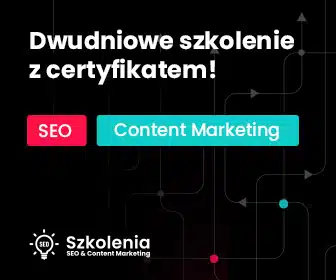The link building process requires time-consuming careful planning and considering many factors that determine whether a link is valuable or not. So what is link building, why is it so important and how to do it effectively?
Link building – what is one of the most important Google ranking factors?
SEO is usually divided into two main areas: on-site and off-site. On-site SEO – as can be deduced from the name – takes place on our website and involves its optimization, both in technical terms and in terms of improving and expanding the content posted there. Off-site SEO, is a set of activities taking place outside our website, which are primarily link building.
Let’s start by answering a simple question: what is a link? Also called a hyperlink, a link is an element of a page that, when clicked, takes us to another place – either within the same website or outside, to another website. You will read about different types of links later in the article, but it is worth mentioning that links transfer SEO power (so-called link juice) from the linking page to the linked page and are therefore crucial from the SEO perspective.
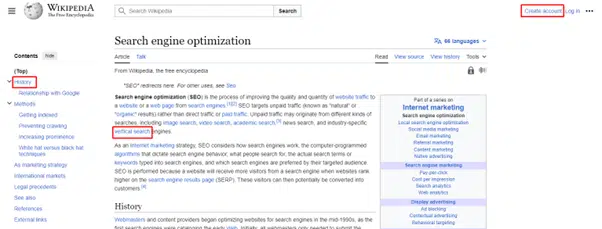
Link building involves acquiring links from other websites to your own website to improve its visibility in search engines. This is usually done by distributing content (sponsored articles, guest posts, press releases, etc.) with a link in the content or in the footer. The more valuable links leading to our website, the greater its authority, which Google (the most popular search engine that SEO specialists focus on) “rewards” with a higher ranking position.
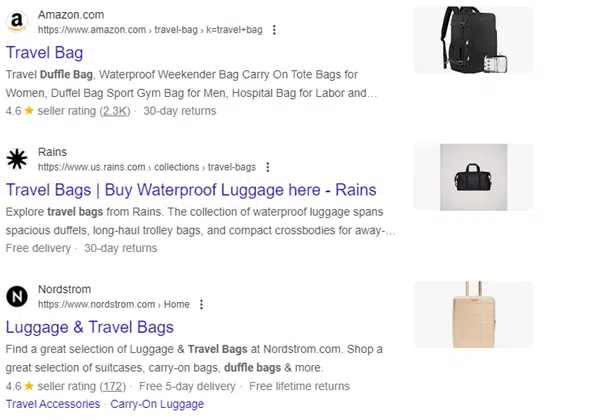
A guide to the types of SEO links you need to know. How important are they to Google’s algorithms?
We distinguish types of links mainly based on the following criteria:
- from where and where they lead (internal and external links),
- what attributes they have in the HTML code and how these “add-ons” change their SEO meaning (dofollow, nofollow, UGC, sponsored links).
Omówimy pokrótce poszczególne typy, dzięki czemu dowiesz się, jak rozpoznać linki SEO friendly, czyli po prostu takie, które niosą korzyści dla Twojej strony.
External and internal links
The division into external and internal links is very simple. Internal links take you to another page within the same website. A well-thought-out and extensive network of internal links is very important from the perspective of on-site SEO. It promotes user engagement and keeps them on our website, and above all, it is like a map for search engine robots – it makes it easier for them to recognize the structure of the website, which benefits subpages in ranking for certain keywords.
External links are all links on the website that lead to other websites. In addition to internal linking, you can also include external links on your website, e.g. to your partners. However, do not exaggerate with their number and be especially careful about site-wide links, i.e. those that appear on all subpages of the website (e.g. in the footer). A specific type of external links are backlinks that point to your website from other services.
Dofollow and nofollow links
The first and basic rule of link building is: links provide link juice to your website, when they have the dofollow attribute. What does it mean? In practice, such links simply do not have additional attributes – that is, they were placed as an “ordinary” user would do in organic linking. Dofollow links usually look like this in the source code:
<a href=”https://semhouse.com/en/”>SEM House</a>
Of course, you can add the rel=”dofollow” or “follow” attribute to it, but it makes no difference to indexing robots.
The nofollow link looks like this:
<a href=” https://semhouse.com/en/” rel=”nofollow”>SEM House</a>
Links with nofollow attributes are definitely less valuable from a link building perspective – because they tell robots not to follow them, your website does not benefit from them.
UGC and sponsored links
Other types of links you may encounter have the attributes rel=”UGC” and rel=sponsored. The UGC (User Generated Content) attribute was created to identify links added by users, not the website owner, e.g. in comments or online forums. This is to counteract unfair practices such as link spamming by bots. UGC links, like nofollow, do not convey SEO power.
The situation is similar with sponsored links. This attribute is used to mark links placed on the website as a result of advertising partnerships. According to Google’s guidelines for webmasters, all paid links should have the sponsored attribute, but remember that it is equivalent to nofollow.
Types of backlinks you need to know to avoid budget burnout
The benefits that backlinks can bring us also depend on how the links are placed in the content, and more precisely: what element the link is hidden under, and how search engine robots and users see it. For this reason, we divide links into text and graphic links. As you can easily guess, graphic links are located under images, icons, etc. Text links, on the other hand, are placed under the anchor text. A lot depends on its construction, so it is worth knowing what types of anchors there are, which ones are particularly worth investing in and why.
Anchor is a text with a link under it. In the HTML code it is contained between <a> tags:
<a href=”https://semhouse.com/en/seo-audit”>SEO audit</a>
It is important information from the perspective of both the user and the indexing robots. Seeing a highlighted fragment of content, a person receives a signal that after clicking, they can further explore the topic that interests them – e.g. that they will be taken to the source of the data provided in the article or that they will be able to buy elegant men’s shoes. What is more, the anchor suggests to search engine robots what topic the linked page is about, which has a positive effect on its ranking in search engines.
There are several types of anchors, among which the most desired by SEO specialists is the exact match (EMA) anchor – identical to the keyword for which we are optimizing, e.g. technical analysis. EMA provides robots with very precise information about the content of the linked page, which increases the probability that after entering this phrase in the search engine, our website will appear in the results. However, the same exact match anchors should not direct to different subpages, as this leads to keyword cannibalization.
The brand anchor contains the name of our brand or company. Partial match links, also called mixed links, consist of a keyword combined with a brand. Another type of anchor you will often encounter is a naked URL: https://semhouse.com/en/brief. There are also no match anchors, including navigation ones, i.e. under the slogans “Check”, “Read more”, etc. Links under such anchors are slightly less attractive from an SEO perspective, but of course they still convey power and diversify the link profile, which will be discussed in more detail below. mentioned below.
If you want to learn how to construct anchor text in the way that helps the search engine understand the topic of the page you are linking to, check out Google’s guidelines for selecting anchor text and other good linking practices: https://developers.google.com/search/docs/crawling-indexing/links-crawlable?hl=en.
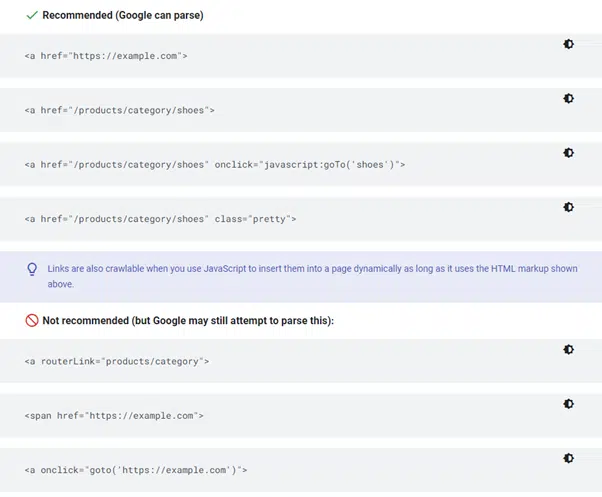
How to acquire strong backlinks? Check what to consider when choosing a place to obtain links
You already know that link power differs based on its type. However, not only the type or number of incoming links is important, but above all their quality. Moreover, if there are a lot of links to our website from suspicious websites, Google may consider it the result of Black Hat SEO and impose a filter on the website that weakens its visibility or bans it completely from organic search results. Therefore, link-building based on trusted sources, although more difficult and time-consuming, is certainly a better strategy for building your position in search engines.
What should be taken under consideration when assessing the value of links and choosing places from which to obtain them? The most important criteria include:
- Relevance, connection with the topic or context. Relevant link building is about ensuring that the link on the website leads to a website with a similar topic. If you are building a link profile for a gaming equipment store, choose portals about gaming or the latest technologies rather than about interior design.
- Authority – the link should come from a website with high credibility. The better the search engine “rates” the page that links to your website, the more power the link passes. Google, of course, does not provide data on this subject, but there are tools whose algorithms can estimate the authority of a website. These are, for example, MOZ (with the Domain Authority indicator), Ahrefs (Domain Rating), Majestic (Trust Flow) and Semrush (Authority Score).

- Ranking and popularity – high visibility and traffic on the website also translate into link strength. Obtaining links from portals with high organic traffic can also contribute to increasing the recognition of your brand.
- Diversity – links to your website should come from various sources and have different anchors (this includes both the content anchors and their different types: URL, graphic, brand, Exact Match, mixed, etc.). This is intended to create an impression of a natural organic link profile.
Sources of external links – where and how to get valuable links?
As we have already mentioned, link building is one of the most important elements of SEO strategy, consuming the most time and resources. However, if you want your website to exist on the Internet and users to be able to reach it, and you expect conversions , you must be proactive and invest in SEO. This brings us to the next question: how to do link building?
Publishing sponsored articles and placing links in articles
The simplest, most popular and most effective method of obtaining backlinks is to purchase sponsored article publications on selected websites. For this purpose, you can contact portal publishers directly, but it takes a lot of time and is not necessarily cheaper than using a specialized content marketing platform. For example, in WhitePress® you will find tens of thousands of portals, as well as tools and indicators that allow you to assess the quality of a domain and, consequently, the potential power of backlinks posted there. An extensive search engine provides information on parameters such as the number of unique users, publication durability, Domain Rating, Trust Flow, etc. You can filter portals by topic, region or offer price.
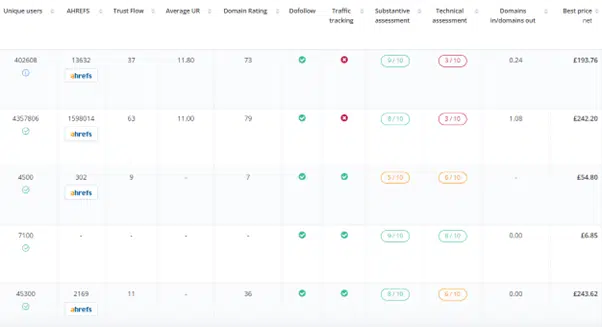
Using modern link-building tools significantly improves the efficiency of the process and facilitates control over already published sponsored articles. Moreover, with many portals to choose from, you can take proper care of the diversity of the link profile, which we have already written above. Remember that the content you prepare for external websites should be as high quality as the content you publish on your website.
Another service available on the WhitePress® platform is placing a link in a finished, already published article on a certain portal. You can then choose editorial material that already ranks high, which translates into both link juice and increased website traffic. You don’t have to worry about indexation either. Remember that the topic of the article and the linked page should match each other, by the principle of link relevance described above.
Guest articles, expert interviews, webinars
Another method of link-building worth mentioning is based on expert content that is attractive to users. You can approach companies in the same or related industry that are not your direct competition and offer to provide an interesting guest article for their blog. Many industry portals will also be happy to publish high-quality content signed by a specialist. If you have the opportunity, you can give an interview or take part in a webinar. Good content is really valuable, and in return, you will get a valuable link to your website, while strengthening your personal brand.
An additional advantage of link-building based on content marketing is the fact that when you create valuable and unique content that will attract attention and arouse the interest of readers, it will be shared and linked organically. It is also an excellent method of building topical authority – domain authority in a given thematic niche. It must be admitted, however, that despite many advantages, this solution can be quite time-consuming and not necessarily cheap.
Social media
Links to your website posted on social media do not provide link juice, but this does not mean that marketing in socials is not worth your time and can be neglected by investing only in traditionally understood SEO. Vibrant social media supports your SEO strategy because this way you can reach users and organically increase traffic to your website. You also build brand recognition and increase authority. At the same time, you can also establish professional relationships that may result in beneficial cooperation and obtaining valuable links from partners.
Affiliate programs and cooperation with partners
An interesting method of obtaining links is to implement an affiliate program – if you already have a customer base, you can offer them, for example, a discount on products/services in exchange for placing a banner with a link to your website.
Even more beneficial is to ask your regular business partners to place backlinks on their websites. This way, you will get links from websites with similar topics and high authority, generating organic traffic with a high sales conversion rate. Thanks to this type of cooperation with partners who do not offer paid links, you also have a chance to get ahead of the competition.
Network monitoring for mentions of the company
When implementing a link-building strategy, especially if you do not have a large budget, it is worth monitoring the Internet on an ongoing basis in search of content about the products or services you offer and, above all, talking directly (in a positive or neutral tone) about your company. If the topic perfectly matches your niche, it is worth contacting the content’s authors and/or publishers of the portals where it was published. Some of them may agree to include a link to your website even free of charge, e.g. as part of a link exchange or in exchange for an expert opinion. It may also be an introduction to other forms of long-term cooperation.
Outreach and link exchange
Outreach marketing means proactive, direct action aimed at establishing a relationship with a company/person with a strong position in the industry you are interested in, so that it supports you in your activities, becomes your partner or even a customer. Many of the above-mentioned methods of obtaining backlinks require outreach, so here we will only mention that in link building it is worth starting by preparing unique content that is exceptionally interesting for users, e.g. an e-book, report or attractive infographics. Then you need to select the websites from which you would like to obtain a link, based on its parameters, position in the search engine or popularity, and approach its owner with a proposal for publication. If your website also ranks well, you can also arrange a link exchange.
Correct NAP enhances your Local SEO
Do you know what a NAP is? The name is an abbreviation of the words Name, Address, Phone and this is the information about your company that you can include there. NAP can be published on specially designed websites and catalogs (such as Targeo, BiznesFinder) and on regional websites. In some of these places, adding a link is also allowed, but even if this is not an option, the consistent NAP across the web increases the recognition of our brand in a given area, so it supports local SEO. You should pay special attention to the quality of the websites where your NAP with a link is placed. If a website has poor parameters and is spammed, it may harm us more than help us.
Private Blog Networks (PBN)
Some companies plan long-term link building, sometimes it involves creating their own SEO infrastructure. Private Blog Networks (PBN) may be associated with spammy sites not intended for human reading. It must be admitted, however, that a series of changes to Google’s algorithms have put an end to this type of practice (known as Black Hat SEO) – in order for links coming from low-quality websites to convey power and not harm the main website, you need to ensure their good parameters. Thanks to this, PBNs are now much more user-friendly, and the quality of the content published there does not differ significantly from the content on “ordinary” websites. They are also usually created on the basis of older domains with established authority. A quality SEO background improves link building and allows for greater control over the entire process, but it is certainly not a solution for everyone. Due to the costs associated with maintaining and running many portals, it is unlikely to be suitable for small and medium-sized companies.
An interesting solution is to support your main website with satellite sites. These are sites that focus on a specific service you offer or a selected category of products in your store. Thanks to focusing on a specific group of keywords and one topic, they respond well to the user’s intention. In this way, they capture traffic for specific searches, which they then redirect to your main website, and of course, they are a source of backlinks over which you have full control.
Link-building strategies, or what can we learn about backlinks from our competition?
When choosing portals for publishing sponsored articles, competitor analysis is also important. Using link gap analysis (which you can perform using e.g. Ahrefs or Semrush), identify the sources of links that these companies have managed to acquire and you haven’t yet. Then add these sites to your strategy and try to partner with them to fill the backlink gap.
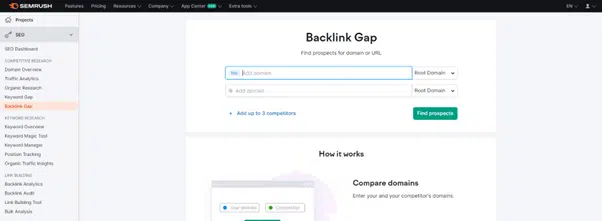
Why competition analysis is a crucial step in a good SEO strategy? First of all, it is a huge time saver, especially if you are taking your first steps in SEO. Take advantage of the knowledge that your business competitors have acquired – in addition to places to publish links, you can take into account the architecture of their websites, the keywords they choose and the content they invest in. Thanks to such insights, you will always keep an eye on the ball and avoid many mistakes, and perhaps you will also discover gaps in your competition’s strategy that will allow you to gain an advantage over them. Combined with regular SEO efforts, this will certainly translate into a visible improvement in your position in the search engine.
Effective link building – why is it so important?
Link building is a key element of effective SEO of your website in the search engine. The more good quality links lead to it, the higher it will rank. This, of course, translates into measurable benefits: increasing the number of website visits and the quality of interactions, and consequently – conversions and sales.
At the same time, it should be remembered that – like all SEO efforts – link building is a long-term process and requires constant optimization and control. Thankfully, there are many tools available on the market that you can use when planning your strategy and analyzing its results on an ongoing basis: Google Analytics and Google Search Console, WhitePress® and Senuto, Semrush, Ahrefs and Moz. It is also worth considering entrusting these activities to SEM House – specialists in SEO and digital marketing. You will then be sure that your link-building strategy is implemented by experts in this field, and its effects will be reported to you on an ongoing basis – and simply visible.
